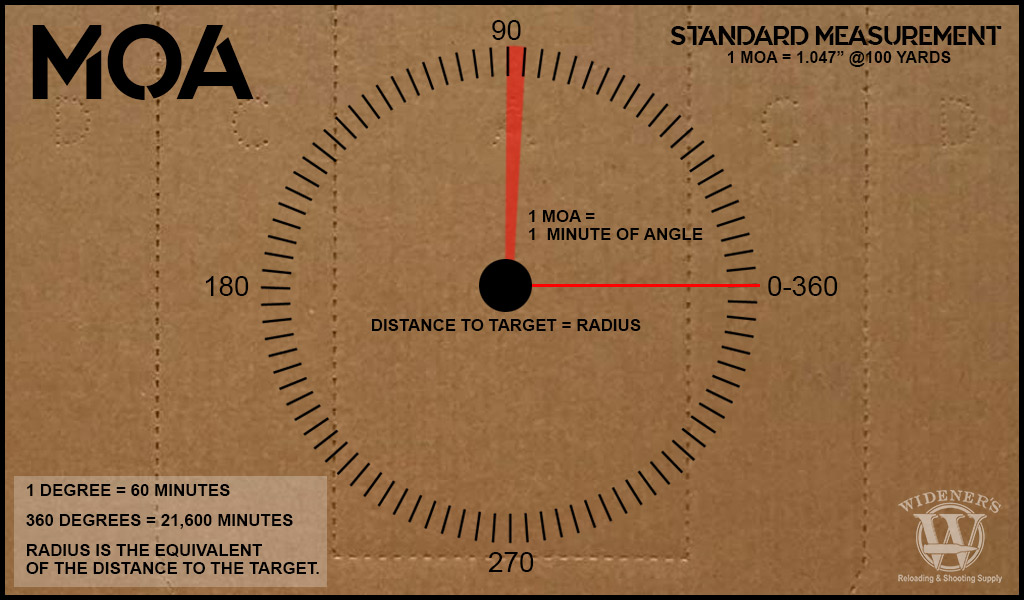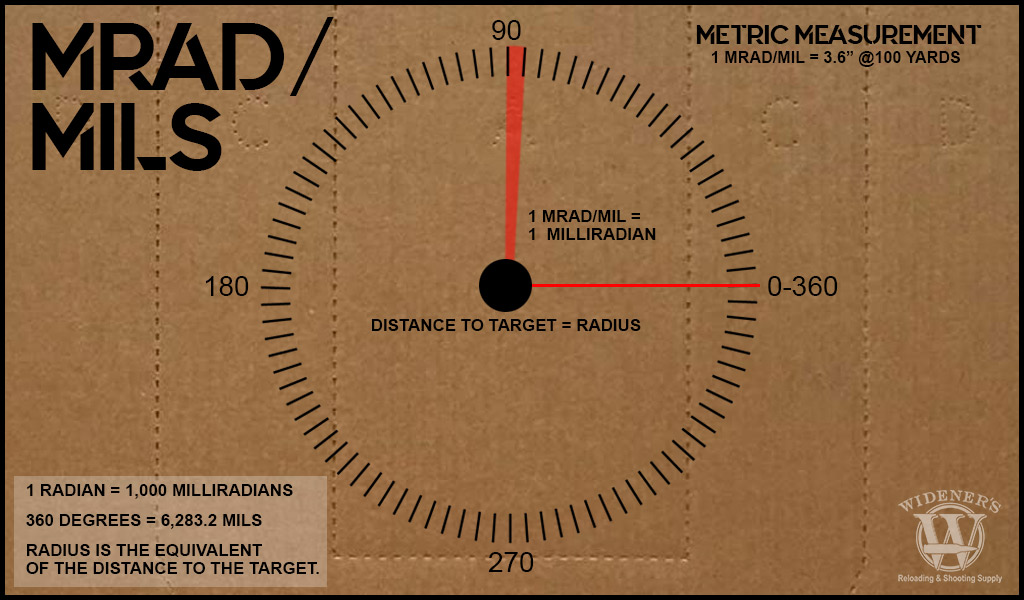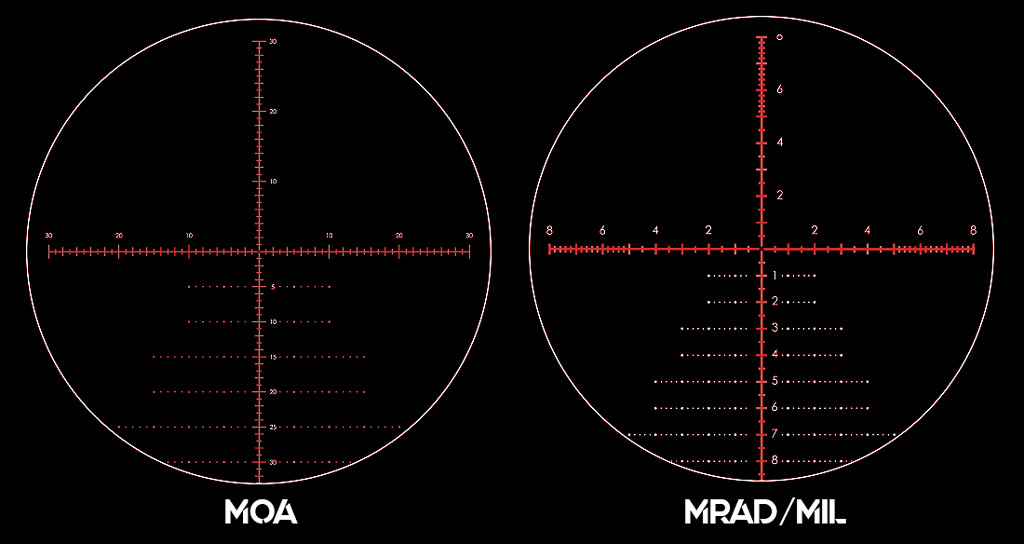

Depending on where you are in the world, people will use different measuring systems. Everyone knows that the US uses the Imperial system, while most of the rest of the world uses Metric. But what fewer people know is that there are two ways of measuring the arc of a circle: minutes of angle (MOA) and milliradians, or Mil, sometimes abbreviated as MRAD.
So, what’s the difference between an MOA vs MRAD (Mil) scope? Simply put, they’re two different measurement systems. They use different numbers to describe the exact same thing. Many shooters who use long-range ammo rely on these measurements as a qualification of accuracy.
But because of the difference in measurement, you sight in an MOA scope differently from an MRAD scope. Depending on what you value as a shooter, one or the other might be better for your needs. Let’s take a closer look, and see how they compare!
MOA Basics

To find your MOA, divide your distance in yards by 100 to determine the size of your MOA in inches.
A minute of angle (MOA) is a measurement based on the ancient Sumerian system. The Sumerians used a base-60 number system, as opposed to our base-10 system. We can thank them for having 60 seconds in a minute, 60 minutes in an hour, and 360 degrees (60 times 6) in a circle.
If you imagine a circle as 360 pie slices, one degree represents the angle of one of those slices. One minute of angle is simply a further subdivision. Each degree can be broken up into 60 minutes, so a minute of angle represents a mere 1/60th of one of those pie slices.
How Does MOA Relate To Shooting?
Imagine that you’re shooting from the center of a giant circle, and your target is on the edge of that circle. Adjusting your scope by one degree will cause the bullet to land one degree higher or lower on that circle.
Unfortunately, at a difference of 100 yards, one degree of angle works out to a difference of 62.83 inches. That’s more than five feet!
So in order to be more accurate, we adjust by minutes, instead of degrees. At 100 yards, one MOA equates to just over one inch (1.047 inches, to be precise). This is why 100-yard targets typically use a one-inch grid. If you shoot a five-round group into one square, you know it’s a sub-MOA grouping.
Another thing to keep in mind is that these numbers can be multiplied out over distance. So at 200 yards, a one-MOA difference works out to 2.094 inches. At 1,000 yards, a one-MOA difference is 10.47 inches. You can calculate the difference in inches at any distance by multiplying the distance in yards by 0.0147.
MRAD/Mil Basics

To find your MIL, multiply your distance in yards by 3.6 and divide the number by 100.
Radians are a different angular measurement, part of the International Standard of Measurements that includes the Metric system. Radians are a bit larger than degrees, though, with 6.2832 radians to a circle instead of 360 degrees.
Much like with degrees, shooters break radians down into smaller units for more accurate sighting. There are 1,000 milliradians per radian, or 6,283.2 mils to a full circle.
At 100 yards, a difference of one mil works out to a difference of 3.6 inches. You can calculate the one-mil difference at any range by multiplying the distance in yards by 0.036. So at 1,000 yards, a mil would measure 0.036 x 1,000, or 36 inches.
MOA vs MRAD: Pros and Cons
At first glance, it might seem like mils aren’t worth using. After all, a one-mil accuracy has you shooting a 3.6-inch group at only 100 yards! Thankfully, that’s not how sighting works.
In fact, most scopes use increments, both for adjusting MRADs and MOAs. When it comes to MRAD scopes, most turrets will adjust the crosshairs in 0.1-Mil increments. In other words, for each click of the dial, your difference at 100 yards is actually only 0.36 inches.
Even at 1,000 yards, one click is only 3.6 inches. That’s even more accurate than an MOA adjustment!
At least, you’d think so, but MOA scopes use a trick of their own. Typically, they adjust in ¼-MOA increments. So for one click of the dial, you’re adjusting your reticle by 0.25 inches at a range of 100 yards. Not too shabby!
Making Adjustments
Keep in mind that these are general guidelines. Some optics for short-range shooting, for example, adjust in either ⅕-mil or ½-MOA increments instead. There are other edge cases, as well. For instance, some sights use a mil-sized red dot, but still adjust in MOA. But those are the exception rather than the rule.
In many cases, the choice to use an MOA or MRAD sight comes down to familiarity. MOA sights have been the standard for years, and most hunters are just plain used to them.
That said, many law enforcement organizations and militaries are switching to MRAD/Mil sights. The main reason for this is that most red dot sights use a one-mil dot. This makes it easy to visualize a one-mil difference at any range, so sighting in is easy.
Because law enforcement and the military are using MRAD/Mil scopes, the civilian tactical market is following along. This only makes sense; people come out of the military or police, they go to buy a civilian gun, and they want a measurement system they’re familiar with.
Making It Click

You may prefer to use MOA for sighting in your hunting scope, and MRAD/MIL for your red dot optics.
As you can see, the difference between an MOA vs MRAD (Mil) scope is a matter of what type of shooting you’re doing. On most scopes, MOA sighting will be more accurate. That said, the difference is minute, and you won’t notice unless you’re very long shots.
Mils aren’t quite as precise as MOA. However, they’re an ideal measurement for red dot sights, which typically have a one-mil reticle. This makes them the superior choice for tactical shooting.
At the end of the day, which system you use is a matter of preference. MRAD/Mils and MOAs are just systems of measurement, not a magical formula. Used properly, either system will get the job done.



